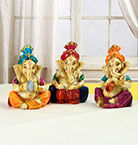About Ganesh Chaturathi
Before knowing totally about the ten day long festival named Ganesh Chaturthi, all of us must learn about Lord Ganesha. Lord Ganesha is also known as Ganapati, Binayak, or Vinayak. He is the most worshipped lord in Hindu culture. Every Hindu festival starts with Lord Ganesha being worshipped first. He is widely known to shower prosperity and luck on his devotees. Lord Ganesha occurred as a distinct deity as early as 4th and 5th centuries AD, and that was the reign of the Guptas. Lord Ganesha was initially included in the group of 5 primary deities in Smartism, a Hindu denomination of the 9th Century. Then the Ganapatya arose who were a group of people having belief that Lord Ganesha is the supreme God. One would find more such mentions and anecdotes about this lord in scriptures like the Ganesha Purana, the Ganapati Atharvashirsa, and the Mudgala Purana along with Brahma Purana and Brahmanda Purana. Lord Ganesha is widely known as the remover of all obstacles but he is also the patron of arts and sciences and the lord of intellect and wisdom. Ganesha is also summoned as patron of letters and learning during writing sessions.
Origin of Ganesha Chaturthi:
As per our Hindu mythology, Lord Ganesha is the son of Shiva and Parvati. He is often regarded as the cutest and the most lovable Indian God. Lord Ganesha or Ganpati has the head of an elephant on which rests a sophisticated tiara, four fleshy hands joined to a sizeable belly. Each hand holds a symbolic object - a trishul or a trident in one, an ankush or goad in the second, a lotus in the third, and a rosary (which is sometimes replaced by modaks,) in the fourth. Lord Ganesha is also known to be a trickster and believed to have a great sense of humor. As per belief, he was born on the fourth day or Chaturthi of the luminous fortnight of the Magh, Hindu Lunar month. An association has been drawn between Lord Ganesha and Chaturthi since then.
The exact day or date of Ganesh Chaturthi is unknown but studies reveal that it was during the reign of Shivaji (1630-1680) when this festival begun to be celebrated publicly. Again according to the research of the historian Shri Rajwade, the earliest Ganesh Chaturthi celebrations can be traced back to the times of Satavahana, Rashtrakuta and Chalukya. When the British people invaded India, this festival lost its glamor and became a very private family celebration. It was Lokmanya Tilak who revived the glory of this festival in Maharashtra.
Some other studies reveal that this Ganesh Chaturthi became a famous event in 1892 when Bhau Rangrai or Bhanusaheb Laxman Javale mounted the very first public or Sarvjanik Ganesha idol in Pune. Now in the year 1893, Lokmanya Tilak praised about this festival in his newspaper named "Kesari". During British India, around 1870 A.D., the British government passed a series of ordinances which put a ban on public assembly for social and political purposes of more than 20 people but only religious assembly for Friday mosque prayers were exempted. As per Tilak this was not justified because in Hindu culture, there is no such necessity of daily or weekly gatherings in temples. Then he leveraged this religious exemption to make Ganesh Chaturthi to evade the British colonial law on large public assembly. He was also one among the first to install large public images of Lord Ganesha in pavilions in Bombay Presidency, and other celebratory events at the festival. Not only that in the year 1893, Tilak also helped in expansion of Ganesh Chaturthi festival into a mass community event and a hidden means for political activism, intellectual discourse, poetry recitals, plays, concerts, and folk dances.






